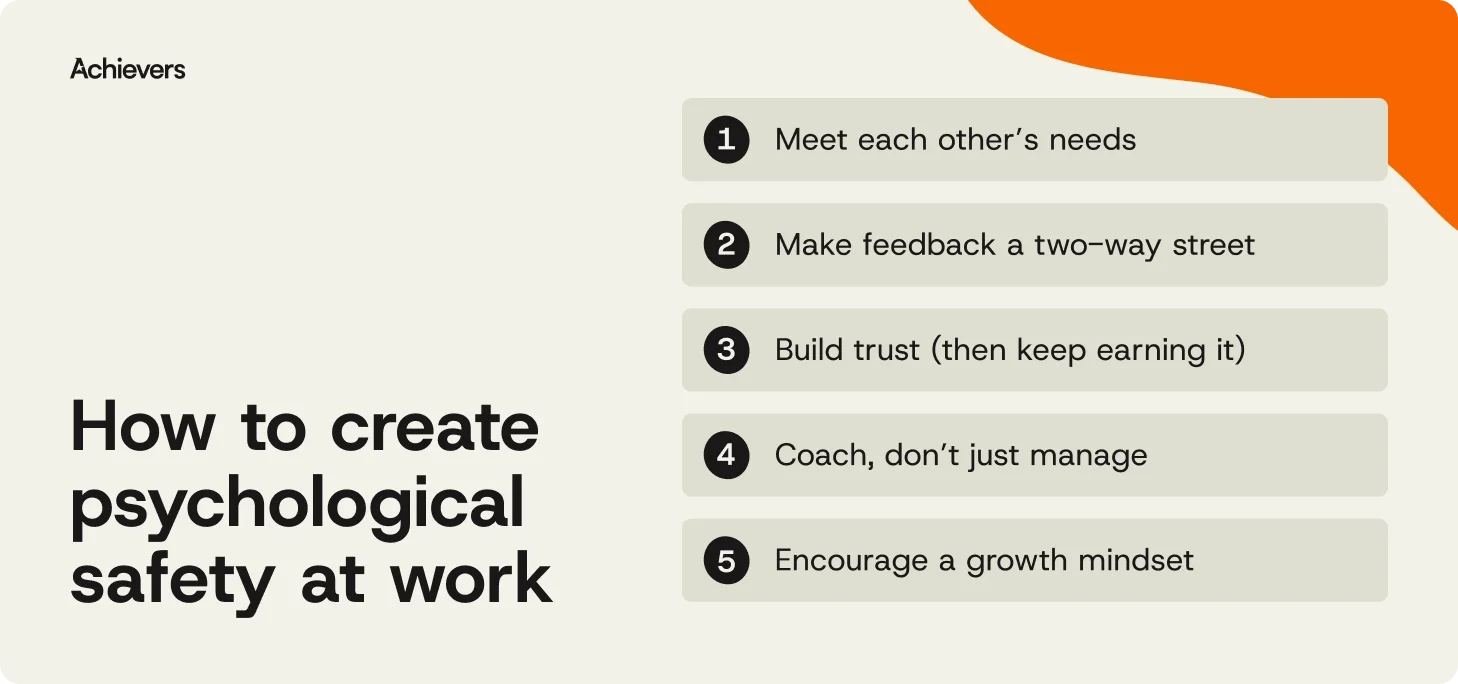Table of contents
Feeling safe at work shouldn’t be a luxury. And yet, the numbers suggest otherwise. The World Health Organization reports a staggering 12 billion workdays lost each year due to depression and anxiety — costing the global economy about $1 trillion annually. Nearly half of all employees face mental health risks, often linked to work-life balance (or the lack of it). And while 93% of executives feel psychologically safe, only 86% of their teams agree. Not a huge gap — unless you’re in it.
That disconnect matters. Because when people don’t feel safe to speak up, share ideas, or admit mistakes, innovation stalls, trust erodes, and organizations stop growing.
So how do you actually build a company culture where everyone feels heard, valued, and — dare we say — human? In this blog, we’ll break down what psychological safety really means, why it’s good business, how countries are tackling it head-on, and how you can create a workplace where people feel safe to show up as themselves. Let’s get into it.
What is psychological safety (and why does it matter so much)?
Psychological safety is the not-so-radical idea that people should be able to speak up at work without fear of being shut down, sidelined, or penalized. When employees feel safe to ask questions, admit mistakes, and share ideas — even the wild ones — teams collaborate better, innovate more, and stress less.
It’s not just good for culture; it’s good for business. And in some places, it’s now the law. In Australia, new legislation effective July 2024 classifies industrial manslaughter — including from psychological harm — as a criminal offense, with fines up to AUD 18 million and prison terms of up to 25 years. If that sounds serious, it is — and it’s part of a broader movement to address psychosocial hazards in the workplace.
Bottom line: psychological safety fuels performance, retention, and trust. The best workplaces know that — and they’re thriving because of it.
11 ways to build psychological safety (without needing a psychology degree)
Creating a culture of psychological safety isn’t just good for your people — it’s good for business. When employees feel safe, supported, and heard, they don’t just survive at work — they thrive. And so does your organization.
So how do you make it happen? Here are 11 practical ways to start building a workplace where everyone feels safe to speak up, step forward, and stick around.

1. Meet each other’s needs
Meeting each other’s needs starts with asking rather than assuming what your team requires. Too often, managers make decisions without consulting their direct reports. Take the time to ask what your employees need in terms of communication, meetings, and feedback. And don’t stop there — needs change, so keep checking in.
It’s easy to assume everyone is the same, but 49% of organizations fail to deliver the employee experience they promised. Acknowledging hard work, providing growth opportunities, and ensuring everyone’s voice is heard all contribute to creating a safe, motivating environment. There’s no one-size-fits-all approach.
2. Make feedback a two-way street
Feedback only works if it flows both ways — and actually leads to action. Asking employees for input but doing nothing with it? That’s a fast track to disengagement. In fact, 62% of employees want to have hard conversations at work but don’t feel safe doing so.
Build trust by listening, responding, and co-creating solutions. Start with pulse surveys — they’re quick, timely, and cut through recency bias to give you the full picture. When employees see their voices leading to real change, they’re more likely to keep sharing. And that’s when the magic (read: results) happens.
3. Build trust (then keep earning it)
Trust isn’t just a warm fuzzy feeling — it’s fuel for performance. When employees trust their managers, they’re more engaged, motivated, and less likely to call in “meh” to work. But here’s the disconnect: while 86% of execs say they trust their teams, only 60% of employees feel that trust. Ouch.
Real trust takes more than good intentions. It needs consistent actions: honesty, empathy, follow-through, and giving people the autonomy to own their work. Skip the top-down approach — empower instead. When employees feel trusted, they don’t just do their jobs — they lean in and show up.
4. Coach, don’t just manage
Coaching builds trust, boosts confidence, and helps employees grow — all essentials for psychological safety. And yet, while 97% of employees say mentorship matters, only 37% have a mentor. For women, it’s even worse: 63% have never had one.
That’s a missed opportunity. Coaching isn’t about hand-holding — it’s about showing up, listening actively, and helping people connect their work to their goals. Encourage leaders to swap micromanagement for mentorship. When managers take time to coach, employees feel seen, supported, and more likely to stick around. And that’s a win for everyone — not just HR.
5. Encourage a growth mindset
Everyone — from interns to execs — has room to grow. Fostering a growth mindset helps employees see challenges as chances, not career-ending catastrophes. When people feel safe sharing missteps or unfinished work, they’re more likely to learn, collaborate, and push boundaries.
That matters, especially since 37% of employees who leave cite lack of growth as the reason. Build a culture where experimenting is encouraged, not penalized. Celebrate learning just as much as results. Because when people believe they can improve, they do — and that momentum fuels stronger teams, smarter decisions, and yes, fewer exit interviews.
6. Create space for bold ideas
Innovation doesn’t happen in a vacuum — it happens in environments where people feel safe enough to speak up, even if their idea sounds a little “out there.” In fact, employees at average innovation companies are 3.6x more likely to fear career consequences for doing just that.
To foster real creativity, leaders need to welcome fresh thinking, respectful debate, and the occasional wild idea. Encouraging bold thinking signals trust — and drives better business outcomes. Because when employees believe their ideas won’t land them in hot water, they’re far more likely to deliver game-changing ones.
7. Show appreciation often
Frequent recognition does more than boost morale — it builds trust and psychological safety. In fact, 53% of employees who receive regular praise from their manager report feeling safe, valued, and free to be themselves at work.
The fix? Make recognition part of the everyday workflow. With the right recognition platform, it’s easy to give kudos in real time — no confetti cannon required. Whether it’s a shoutout for a big win or a quiet thank-you for a job well done, frequent appreciation fosters connection, reinforces the right behaviors, and reminds people their work actually matters. Because it does.
8. Nip negativity in the bud
Negativity spreads fast — and not in a fun, viral way. A study found that 1 in 5 workers experienced harm to their mental health at work, and 22% reported harassment. That’s a clear sign: toxic behavior erodes trust and psychological safety.
If someone’s bringing the vibe down, don’t ignore it. Check in with curiosity, not judgment. Negative behavior often stems from deeper issues — personal stress, communication gaps, or feeling unheard. Tackle it with empathy and action. Addressing the root causes of a toxic work environment shows you care about both the individual and the team. Because silence? That’s not leadership.
9. Lead with empathy (and mean it)
Empathy gets a lot of lip service — but not always a lot of follow-through. In fact, 52% of employees say their company’s empathy efforts feel insincere (ouch). Real empathy means listening to understand, not just to respond.
Start simple: summarize what you’ve heard, check your body language, and show genuine interest. These small signals go a long way in making others feel respected and heard. And don’t forget to say thank you — appreciation and empathy go hand in hand. When empathy is real, trust grows, collaboration strengthens, and people actually enjoy working together. Imagine that.
10. Make decisions with your team, not just for them
Psychological safety ranks just behind pay and flexibility for employees — 84% say it’s a top workplace priority. And no surprise: people want to feel included, not overruled.
So, involve your team in decisions that impact them. Ask for input, review feedback together, and be transparent about how choices are made. It builds trust, boosts engagement, and strengthens the team dynamic. Plus, it helps avoid the dreaded “why didn’t anyone tell me?” moments. When employees feel heard and informed, they’re more likely to stay committed — and less likely to mute the next meeting invite.
11. Empower managers to lead with confidence
Psychological safety starts with managers — but only 27% feel prepared to handle tough conversations. That’s a problem, especially when 89% of business leaders say psychological safety matters.
The fix? Equip managers with tools and training in communication, empathy, and conflict resolution. Give them access to pulse surveys and anonymous feedback to spot issues early and respond with care. When managers feel confident leading hard conversations, teams feel safe speaking up. And when every idea, question, or concern is met with curiosity (not judgment), trust builds — and so does performance. Better leaders, better culture, better results.
How to check the pulse on psychological safety
You can’t fix what you don’t measure — and psychological safety is no exception. But before you break out the spreadsheets, remember: this is about people, not just metrics. Here’s how to approach it with care (and a little curiosity):
- Start with clarity: Make sure your team understands what psychological safety is — and why it matters.
- Create a safe space to assess: Confidentiality is key. No one shares honestly if they’re worried it’ll come back to bite them.
- Pick your tools: Use pulse surveys, anonymous feedback forms, or a trusted index like the Psychological Safety Index.
- Listen and observe: One-on-ones, group chats, open-ended questions — it’s about conversation, not interrogation.
- Watch team dynamics: Body language often says more than words. (A silent Zoom square speaks volumes.)
- Dig into the data: Look for trends, blind spots, and areas to improve.
- Share what you learn: Feedback goes both ways — let your team know what surfaced and what’s next.
- Build a plan together: Co-create solutions, set goals, and take action as a team.
- Keep the loop going: Follow up regularly. Psychological safety isn’t a one-and-done — it’s ongoing.
- Support with training: Offer tools and development for leaders and teams.
- Model it daily: Show what psychological safety looks like in action — because culture starts at the top (and spreads sideways).
When in doubt, listen more, judge less, and keep the door — and your mind — open.
Make psychological safety part of your culture
The best workplaces don’t just talk about psychological safety — they live it. And when employees feel safe, valued, and heard, they show up as their best selves (and tend to stick around).
Creating that kind of culture doesn’t happen by accident. It takes consistent feedback, everyday recognition, and tools that make both feel natural — like Achievers.
Ready to build a workplace where people want to work (and stay)? Let’s make it happen.



